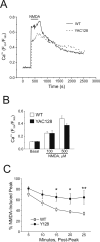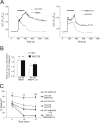Mitochondrial sensitivity and altered calcium handling underlie enhanced NMDA-induced apoptosis in YAC128 model of Huntington's disease
- PMID: 18077673
- PMCID: PMC6673605
- DOI: 10.1523/JNEUROSCI.3455-07.2007
Mitochondrial sensitivity and altered calcium handling underlie enhanced NMDA-induced apoptosis in YAC128 model of Huntington's disease
Abstract
Expansion of a CAG repeat in the Huntington's disease (HD) gene results in progressive neuronal loss, particularly of striatal medium-sized spiny neurons (MSNs). Studies in human HD autopsy brain tissue, as well as cellular and animal models of HD, suggest that increased activity of NMDA-type glutamate receptors and altered mitochondrial function contribute to selective neuronal degeneration. In this regard, the YAC128 mouse model, expressing full-length human huntingtin with 128 glutamine repeats, has been the focus of much interest. Although NMDA-induced apoptosis is enhanced in YAC128 MSNs, here we report that the initial steps in the death signaling pathway, including NMDA receptor (NMDAR) current and cytosolic Ca2+ loading, are similar to those observed in wild-type MSNs. In contrast, we found that the NMDAR-mediated Ca2+ load triggered a strikingly enhanced loss of mitochondrial membrane potential in YAC128 MSNs, suggesting that NMDAR signaling via the mitochondrial apoptotic pathway is altered. This effect was accompanied by impaired cytosolic Ca2+ clearance after removal of NMDA, a difference that was not apparent after high potassium-evoked depolarization-mediated Ca2+ entry. Inhibition of the mitochondrial permeability transition (mPT) reduced peak cytosolic Ca2+ and mitochondrial depolarization evoked by NMDA in YAC128 MSNs but not wild-type MSNs. Hence, in contrast to YAC models with moderate CAG expansions, the enhanced NMDA-induced apoptosis in YAC128 MSNs is predominantly determined by augmented mitochondrial sensitivity to Ca2+-induced activation of the mPT. These results suggest that the CAG repeat length influences the mechanism by which mHtt enhances NMDAR-mediated excitotoxicity.
Figures






Similar articles
-
Full length mutant huntingtin is required for altered Ca2+ signaling and apoptosis of striatal neurons in the YAC mouse model of Huntington's disease.Neurobiol Dis. 2008 Jul;31(1):80-8. doi: 10.1016/j.nbd.2008.03.010. Epub 2008 Apr 16. Neurobiol Dis. 2008. PMID: 18502655 Free PMC article.
-
Polyglutamine-modulated striatal calpain activity in YAC transgenic huntington disease mouse model: impact on NMDA receptor function and toxicity.J Neurosci. 2008 Nov 26;28(48):12725-35. doi: 10.1523/JNEUROSCI.4619-08.2008. J Neurosci. 2008. PMID: 19036965 Free PMC article.
-
P38 MAPK is involved in enhanced NMDA receptor-dependent excitotoxicity in YAC transgenic mouse model of Huntington disease.Neurobiol Dis. 2012 Mar;45(3):999-1009. doi: 10.1016/j.nbd.2011.12.019. Epub 2011 Dec 14. Neurobiol Dis. 2012. PMID: 22198502
-
N-methyl-D-aspartate (NMDA) receptor function and excitotoxicity in Huntington's disease.Prog Neurobiol. 2007 Apr;81(5-6):272-93. doi: 10.1016/j.pneurobio.2006.11.003. Epub 2006 Dec 22. Prog Neurobiol. 2007. PMID: 17188796 Review.
-
Pathophysiology of Huntington's disease: time-dependent alterations in synaptic and receptor function.Neuroscience. 2011 Dec 15;198:252-73. doi: 10.1016/j.neuroscience.2011.08.052. Epub 2011 Aug 27. Neuroscience. 2011. PMID: 21907762 Free PMC article. Review.
Cited by
-
TNF-α Triggers RIP1/FADD/Caspase-8-Mediated Apoptosis of Astrocytes and RIP3/MLKL-Mediated Necroptosis of Neurons Induced by Angiostrongylus cantonensis Infection.Cell Mol Neurobiol. 2022 Aug;42(6):1841-1857. doi: 10.1007/s10571-021-01063-w. Epub 2021 Mar 8. Cell Mol Neurobiol. 2022. PMID: 33683530 Free PMC article.
-
Mutant huntingtin and mitochondrial dysfunction.Trends Neurosci. 2008 Dec;31(12):609-16. doi: 10.1016/j.tins.2008.09.004. Epub 2008 Oct 24. Trends Neurosci. 2008. PMID: 18951640 Free PMC article. Review.
-
Mutant Huntingtin and Elusive Defects in Oxidative Metabolism and Mitochondrial Calcium Handling.Mol Neurobiol. 2016 Jul;53(5):2944-2953. doi: 10.1007/s12035-015-9188-0. Epub 2015 May 5. Mol Neurobiol. 2016. PMID: 25941077 Free PMC article. Review.
-
VCP recruitment to mitochondria causes mitophagy impairment and neurodegeneration in models of Huntington's disease.Nat Commun. 2016 Aug 26;7:12646. doi: 10.1038/ncomms12646. Nat Commun. 2016. PMID: 27561680 Free PMC article.
-
Shaping the role of mitochondria in the pathogenesis of Huntington's disease.EMBO J. 2012 Apr 18;31(8):1853-64. doi: 10.1038/emboj.2012.65. Epub 2012 Mar 23. EMBO J. 2012. PMID: 22446390 Free PMC article. Review.
References
-
- Abdel-Hamid KM, Baimbridge KG. The effects of artificial calcium buffers on calcium responses and glutamate-mediated excitotoxicity in cultured hippocampal neurons. Neuroscience. 1997;81:673–687. - PubMed
-
- Alano CC, Beutner G, Dirksen RT, Gross RA, Sheu SS. Mitochondrial permeability transition and calcium dynamics in striatal neurons upon intense NMDA receptor activation. J Neurochem. 80:531–538. - PubMed
-
- Banke TG, Traynelis SF. Activation of NR1/NR2B NMDA receptors. Nat Neurosci. 2003;6:144–152. - PubMed
-
- Bano D, Young KW, Guerin CJ, Lefeuvre R, Rothwell NJ, Naldini L, Rizzuto R, Carafoli E, Nicotera P. Cleavage of the plasma membrane Na+/Ca2+ exchanger in excitotoxicity. Cell. 2005;120:275–285. - PubMed
-
- Bittenbender JB, Quadfasel FA. Rigid and akinetic forms of Huntington's chorea. Arch Neurol. 1962;7:275–288. - PubMed
Publication types
MeSH terms
Substances
LinkOut - more resources
Full Text Sources
Other Literature Sources
Medical
Molecular Biology Databases
Miscellaneous
